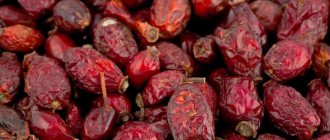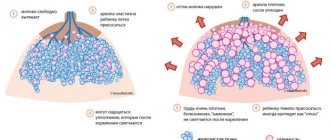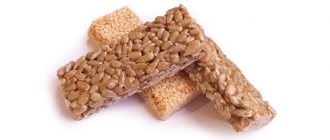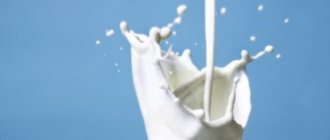Breastfeeding a child is an individual and somewhat intimate issue. In our society, not everyone yet perceives breastfeeding as a natural process. But according to Rosstat data for 2021, 40% of children under one year of age are breastfed. This figure is increasing every year.
The well-being of breastfeeding does not depend on a woman’s natural abilities, but on her awareness in this area. Simply put, every expectant mother should know how breast milk is produced, what makes it unique and how to organize feedings.
Women's breast milk is an amazing product that nature itself provided for feeding babies. It is produced from the mother's blood and lymph.
“One drop of mother's milk contains 1000 living cells. A glass of the adapted mixture does not contain any "
This article describes all the incredible facts about this unique product, which is commonly called “white gold”.
Composition of breast milk
The milk in a woman's breast contains 500 valuable substances for the baby's nutrition. Its composition is constantly changing and adapting to the needs of the child. Today, the food industry is not able to produce an adapted formula that 100% replicates the composition of human milk. And even the most ingenious technologist will not be able to make it biologically active, capable of changing depending on the needs of the child.
The chemical composition of breast secretion is as follows:
- Dry matter - 11.9%
- Fat - 3.9%
- Protein - 1.0% (including casein - 0.4%)
- Lactose - 6.8%
- Minerals - 0.2%
Expanded table of the chemical composition of breast milk in comparison with an adapted formula
Protein
A woman's breast milk contains whey proteins: globulins and albumins. They are easily absorbed by the newborn's body. The content of casein (a protein complex in structure and difficult to digest) in human milk is 10 times less than in cow's milk.
The combination of whey proteins and oleic acid forms a complex of substances called HAMLET. This complex protein detects and destroys potential cancer cells in a child's body. This reduces the risk of developing cancer.
The protein in milk envelops the walls of the baby's intestines with a thin protective film, which reduces pain during colic and gas formation.
Fats
A woman's breast milk contains 2 times more polyunsaturated fatty acids than cow's milk. Its fat content varies depending on the fullness of the breast. At the beginning of feeding, the baby receives foremilk, the fat content of which is low. Towards the end of feeding - fattier, hind milk.
The fat content of this nutritious product does not depend on the fat content of the food that the mother eats. But if a woman’s diet is rich in polyunsaturated fatty acids, then milk increases its beneficial qualities.
Carbohydrates
Carbohydrates in milk are represented largely by lactose and other oligosaccharides, which contribute to the development of microflora in the child’s intestines.
When digested, lactose is broken down into galactose and glucose, which supplies the child’s brain with the necessary energy. It also plays an important role in the absorption of calcium.
Enzymes
Breast milk contains the enzymes necessary for the absorption of protein and fatty acids: lipase, amylase, trepsin and pepsinogen. In the first months of life, the digestive tract of a newborn does not produce enough enzymes to digest food. Mother's milk contains all the necessary auxiliary substances for assimilation of itself.
Immune defense factors
During breastfeeding, the mother transfers antibodies to the child: immunoglobulins, lactoferyl, interferon, which form the newborn’s immunity to various diseases. During diaper changing, bathing, breastfeeding, hugging and kissing, pathogenic microflora from the child’s body enters the mother’s body. The mother's lymphatic system releases immunoglobulins into the blood in response to the pathogen. Some of the antibodies enter the milk. Thus, the child receives antibodies that are necessary in the fight against microorganisms. Precisely those that threaten mother and child at a given time.
Biological activity of breast milk
Milk renewal occurs constantly. It changes its composition (the ratio of proteins, fats and carbohydrates) during one feeding, during the day and with the age of the child. Adapts to his age needs.
Closer to 4 months, the amount of calcium increases. Since the baby’s body requires calcium to form the skeleton. During a child's illness, mother's milk is enriched with painkillers. And in case of illness of the mother, the child is protected by antibodies, which he receives with milk.
The benefits of breast milk and the diet of a nursing mother
Everyone knows that mother’s milk is the best nutrition for a baby, because it is adapted to the baby’s needs by nature itself. Natural feeding throughout the existence of mankind ensures children not only survival, but is also a guarantor of their normal physical and neuropsychic development. The nutrients in breast milk are especially necessary for the baby in the first 6 months of life. If you have decided to breastfeed your baby, then you will be pleased to know about some of the positive aspects of this type of feeding for mother and newborn.
The benefits of breastfeeding for your baby
- Mother's milk provides the baby with all the necessary substances for up to 4-6 months (including polyunsaturated fatty acids, immunoglobulins and easily digestible iron), protects against infections, reduces the risk of developing allergic diseases (even if there are allergies in the family) and digestive diseases.
- Colostrum, produced in the mammary glands in the first 2-4 days after birth, contains high-value proteins, antibodies, vitamins (A, C, E, B12), salts (copper, zinc, iron) and immune cells that protect the health of the baby. It has a mild laxative effect and promotes timely cleansing of the newborn’s intestines from original feces - meconium.
- Breast milk is easily digestible and quickly digested, as a result of which infants are less likely to suffer from constipation, diarrhea, intestinal colic and other digestive problems (including gastrointestinal infections). In this case, the child can have stool up to 6-8 times a day, that is, after almost every feeding.
- According to some data, breastfeeding reduces the risk of a baby developing diabetes mellitus, obesity, atherosclerosis and hypertension in older age.
- Mother's milk ensures harmonious psychomotor and emotional development and contributes to the formation of normal intelligence in the future.
- Breastfed children have closer contact with their mother, are friendly and sociable.
- Breast milk significantly reduces the incidence of sudden death syndrome; children are less likely to experience enterocolitis, sepsis, otitis media, diarrhea, atopic dermatitis, food allergies, and bronchial asthma. Plus, dental problems (for example, tooth decay) are also much less common in former infants than in those who ate from a bottle.
The benefits of breastfeeding for mom
- When breastfeeding, the hormone oxytocin is released, which causes the uterus to contract. As a result, postpartum bleeding ends faster. In general, this hormone is an excellent natural remedy for preventing bleeding in a young mother and in the future.
- Women who breastfeed are less likely to get ovarian and breast cancer.
- It is easier for a nursing mother to regain her shape after childbirth, since excess fat accumulated during pregnancy is converted into energy necessary to maintain lactation.
- Breastfeeding promotes emotional satisfaction for the mother and the establishment of a close relationship with the baby.
So, we have established that breastfeeding has significant benefits for both the newborn and his mother. Milk is healthy, nutritious, balanced, strengthens the child’s immunity, plays a significant role in the psychological process of establishing contact between mother and baby and creates a sense of trust. It is always available, ready to use, has an optimal temperature and does not require sterilization. In addition, the mother has exactly as much milk as her baby needs, since there is a direct relationship between milk production and the baby’s sucking pattern (its duration and intensity).
The facts listed above certainly deserve attention, but for many women the decision to breastfeed is still not easy. This is due to the fact that natural feeding is associated with a number of possible inconveniences. Among them are the appearance of cracks in the nipples, and inevitable discharge from the breast, and difficulties with lactation (either milk arrives in excess quantities, or, on the contrary, disappears), and, among other things, the need to adhere to a certain diet. We’ll talk a little more about the diet of a nursing mother.
Diet of a nursing mother
It has been proven that the mother's weight, the amount of fluid consumed, and even the shape and size of the breasts have virtually no effect on the success of lactation. The dietary requirements for a nursing woman also vary over a fairly wide range, although the value of this parameter is much higher than all the previous ones. A young mother should eat right, first of all, for the sake of her own baby. The fact is that the composition and other characteristics of milk change depending on what products form the basis of her menu. The baby’s digestive system is just beginning its work; the enzymes necessary for this are not yet sufficient, so the response to the nurse’s intemperance in food will most likely be intestinal colic and bloating.
Recommended daily food intake for lactating women (developed by the Research Institute of Nutrition of the Russian Academy of Medical Sciences):
| Products | Quantity (grams) |
| Wheat bread | 150 |
| Rye bread | 100 |
| Wheat flour | 20 |
| Cereals, pasta | 70 |
| Potato | 200 |
| Vegetables | 500-600 |
| Fruits | 200-300 |
| Juices | 150 |
| Dried fruits | 20 |
| Sugar | 60 |
| Confectionery | 20 |
| Meat, poultry | 170 |
| Fish | 70 |
| Milk and fermented milk products (2.5% fat) | 1000 |
| Cottage cheese (9% fat) | 100-150 |
| Sour cream (10% fat) | 15 |
| Butter | 35 |
| Vegetable oil | 15 |
| Egg | 1 piece |
| Cheese | 20-30 |
| Tea | 1 |
| Coffee | 3 |
| Salt | 8 |
So, nutrition should be varied and nutritious . A nursing mother's menu should include buckwheat and oatmeal porridge (as well as semolina and corn, cooked in water), compotes (best from her own dried fruits: apples, pears, dried apricots) and even berries. But onions, garlic, horseradish, spices and herbs that give breast milk an unpleasant taste should not be consumed. You will need to exclude fatty and fried foods from your diet. Meat delicacies are prepared during this period from rabbit, turkey, lean pork or lamb. For fresh fruits, it is recommended to choose green apples, pears (without peel) and bananas. You should eat food 4 to 6 times a day, in small portions. Interestingly, having a snack before each feeding promotes more intense milk production.
The daily diet must include milk and dairy products. It is useful to add milk to tea (weak, green or black, without aromatic additives), and among other fermented milk products you can use bifidoc, acidophilus, cottage cheese (it’s better to start with 0%, low-fat), organic yogurt without additives, low-fat goat cheese (as well as cheeses Gouda, Edamer and other mild and low-fat varieties).
How to prevent allergies . A nursing mother should be careful about foods that can cause allergies in her baby. Of course, each baby has its own characteristics and it is impossible to determine in advance which product will have an undesirable reaction. However, most often the following are considered dangerous in this regard: strawberries, raspberries, red varieties of apples, cherries, carrots, citrus fruits, pineapples, coffee, cocoa, chocolate, strong meat broths, excess eggs, fish, sausages, products with preservatives (juices, semi-finished products, confectionery). Remember that grapes, mushrooms, legumes and raw cabbage can disrupt a child’s digestion and cause increased gas production - these foods should also be avoided.
A useful rule . A young mother is forced to endure the greatest restrictions in the first month of her baby’s life, when his digestive system is especially sensitive to any foreign substance. In the future, a woman can gradually introduce additional foods into her diet. At this point, the rule of adding only one new “dish” per day is very useful. In this situation, you can always notice which “line” of your menu the baby did not react too well to (for example, he developed red spots on his face or increased gas formation, intestinal colic), and cross it off the list until better times.
Foremilk and hindmilk
Foremilk and hind milk differ in color and consistency. The first is translucent with a bluish tint, contains a small percentage of fat and a lot of water. The second is thick yellowish in color, more fatty.
Foremilk quenches the baby's thirst, and hind milk satisfies his nutritional needs.
In fact, the separation of foremilk and hindmilk is a relative concept. It's just that the foremilk is liquid and flows to the nipple first. And the back is fattier and thicker. The child has to make an effort to get it.
Comparison of foremilk and hindmilk
How is breast milk produced?
Milk matures in special cells that make up the lactating mammary gland - the alveoli.
When a baby sucks at the breast or stimulates the nipples by pumping, it triggers the production of lactation hormones: prolactin and oxytocin.
Prolactin is responsible for milk production. After feeding, its level rises and a signal is sent to the mother’s brain to produce a new portion of milk. Under the influence of oxytocin, the muscle tissue around the alveoli contracts and pushes milk into the milk ducts.
Mechanism of breast milk production
In the last weeks of pregnancy and the first 3-4 days after birth, the mother's mammary glands produce colostrum.
Colostrum
Colostrum is a thick secretion of the mammary glands with a salty taste and yellowish-orange color. After childbirth, very little colostrum is released - just a couple of drops. But this amount is enough to feed a newborn in the first days after birth.
The composition of colostrum is closer to blood than to mature human milk. The energy value of colostrum is much higher than mature milk. Colostrum contains an average of 15% protein, immunoglobulins, as well as natural antioxidants in large quantities: vitamins A, E. Immune defense factors: immunoglobulins, leukocytes-macrophages, lymphocytes envelop the intestinal walls and protect it from bacteria, parasites, viruses. Colostrum contains little water and is fatty and viscous. But this is provided by nature, because in the first few days a newborn does not need water, so as not to put a strain on the kidneys.
Colostrum has a laxative effect on the newborn's intestines. This is necessary to release the original stool - meconium. The sooner the meconium is passed, the less chance the baby will develop physiological postpartum jaundice.
In a word, colostrum is an indispensable product for a child, which starts the child’s gastrointestinal tract and provides nutrition from the first days of life.
Transitional and mature milk
Colostrum is replaced by transitional milk after 3-4 days. It remains in this composition for 2 weeks, and then changes to mature. Mature milk is characterized by an increase in sugar content and a decrease in protein content.
When feeding a baby on demand, the mother does not have problems with a lack of milk. Frequent stimulation of the breast leads to the release of lactation hormones and milk production.
Another factor responsible for the formation of milk is a special substance called a “lactation inhibitor.” This protein is found in breast milk itself and inhibits its production. This means that the longer milk is retained in the breast, the less milk will be produced. During the emptying of the breast, the inhibitor is excreted along with the milk and a signal is sent to the brain about the need for a new portion of milk. In this way, milk production is regulated: the more regularly the breasts are emptied, the more they are filled with new milk.
Breast milk is the ideal product for your baby
The fact is that breast milk is ideal for a child’s digestion. Any other product, scientifically selected and calculated, will still have some side effect on the baby’s body. What are the benefits of breast milk? It contains ALL the nutrients a baby needs. The baby's gastrointestinal tract is still developing, enzyme systems and the functional state of the kidneys are not developed, and the immune system is weak. And breastfeeding ensures the child’s adaptation to life outside the womb.











